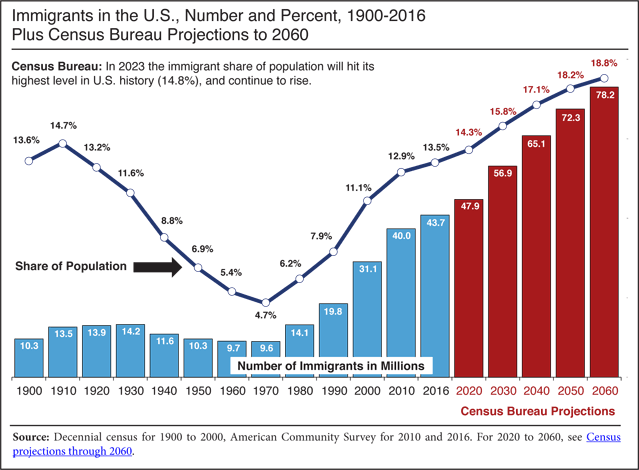A Center for Immigration Studies (CIS) report published Monday shows there were more immigrants – at least 43.7 million – in the United States in 2016 than ever before.
The analysis, based on the U.S. Census Bureau’s 2016 American Community Survey (ACS), includes both legitimate immigrants and illegal aliens. Because of a separate Department of Homeland Security report about the ACS numbers, CIS, a pro-American anti-mass migration think tank, estimates the real figure is even higher, at 45.6 million.
Never before has America sustained such a large foreign-born population. As recently as 1970, just before the epoch-defining Immigration and Nationality Act of 1965, popularly known as the Hart-Cellar Act after its co-sponsors Rep. Phillip Hart (D-MI) and Rep. Emanuel Cellar (D-NY) began fundamentally transforming patterns of migration to the United States, there were fewer than 10 million immigrants, including illegals, in the country.
As significant as the absolute number is the proportion. More than one in eight people in the United States in 2016, 13.5 percent, were not born here. An additional 16 million were the minor children of immigrants, meaning nearly one in five people was living in an immigrant household.
Only once before in American history has the proportion of the population born abroad exceeded that of 2016. At the absolute peak of the 1880-1920 immigration wave, just after the 1910 Census, a slightly higher figure of 14.8% was recorded. CIS estimates that even that record will be shattered by 2023 and, if current policy is left in place, the immigrant population will nearly double again by 2060.
The last time a similar peak of immigrant proportion was reached in the 1910s, broad bipartisan support passed the 1921 and 1924 Immigration Acts, which kept the absolute numbers of foreign-born people in America stable for two generations. By 1970, fewer than one in 20 people in the United States were born abroad.
Sen. Ted Kennedy (D-MA) justified passage of the 1965 Immigration Act, of which he was a key sponsor, by promising on the Senate floor, “[O]ur cities will not be flooded with a million immigrants annually … Secondly, the ethnic mix of this country will not be upset.”
Both promises proved woefully inaccurate. Typical legal migrant flows under the immigration system inaugurated by the 1965 act have exceeded 1.1 million people for years. They are augmented by an unclear number of illegal aliens who avail themselves of a porous southern border and patchy interior enforcement. Estimates range as high as 30 million, but the Census Bureau puts the figure around 11 million.
The CIS report vividly illustrates the failure of Kennedy’s second claim. While, in the last peak of immigration, in the 1910s, virtually all inflow was from Europe, today only around 4.8 million of the 43.7 million foreign people are from Europe. Instead, more than half, 22.3 million, are from Latin America, with more than 11 million from Mexico alone. Another 11 million are from East and South Asia, with more than two million each from China and India. It is those two Asian economic giants, with a combined population of over two and a half billion, that have, according to the CIS report, seen the largest increase in immigration numbers since 2010.
Muslim immigrants, meanwhile, numbered over 2.8 million in 2016, up from only 840,000 in 1990.
While the overall increase in immigrant numbers from 2010-2016 was a mere nine percent, the localized effect was often far more striking. For example, North Dakota saw a 48 percent increase in immigrants, West Virginia 41 percent, and South Dakota 39 percent in just six years.


COMMENTS
Please let us know if you're having issues with commenting.